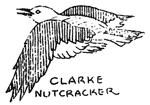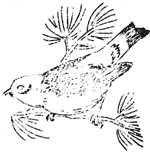|
Volume VII No. 2 - August, 1934
We And The Birds - Garfield Peak
By W. Craig Thomas, Ranger-Naturalist
This morning, let us take a stroll up Garfield Peak Already we can
hear the songs of birds that have learned better than human beings how
to sing at their work.
As we pass the Lodge, going along the rock wall, a wise-looking
marmot surveys us with dignity appropriate to his station and slides off
the other side of the wall. When we reach the place, however, he has
vanished within the rocks. But a sudden sweet song allays what
disappointment we may feel. It is the tinkle bell song, the thrill of
Thurber's Junco. And then we see him, perched at the very tip of a
small tree, sending his lovely thread of song into the surrounding
forest. The female is busy gathering tiny insects and seeds in the
dense grasses and plants at the foot of the tree. Her nest is carefully
hidden under the leaves of the trailing currant, but if we watch we can
find it. We notice, also, that her beak is heavy and thick, in order to
crack the shells from seeds that she many find. But while we are
watching her, we become conscious of another song, the metallic buzz of
the Western Chipping Sparrow. And suddenly we see him, perched on the
top of a stump in the little meadow. His locust-like song comes thinly
across to us, and fearing to frighten him, we stay where we are. But
through the glasses, we can see the chestnut patch on the top of his
head, and the heavy beak that marks him as another seed-eater.

We are rudely interrupted in our bird watching by the raucous cries
of some argumentative Clark's Nutcrackers. In the top of a dead snag,
they flaunt their family rows to the whole world which unfortunately is
not very interested. And then we see the animated beauty and the dark
grey of Allen's chipmunk. We had seen already the smaller and brighter
Klamath chipmunk scurrying near the rim as we started. The
golden-mantled ground-squirrel we already also knew as the little beggar
of the rocks, forever asking, however silently, for a hand-out.
Then as we go on past the meadow toward the rim and the broken
colors of the rock slide, from trees along the path, we hear two songs
so much alike that we must listen carefully to detect the difference.
One we are sure is the purple finch, Cassin's in this altitude, and soon
we see him, his red head shining against the background of mountain
hemlocks. His beak, too, is heavy, so we automatically place him with
the junco and the chipping sparrow as a seed-eater. The other song we
think comes from the Lincoln sparrow but he is too hard to find in our
limited time so we go on up the trail.

But we do not proceed far, when the sudden flash and beauty of
yellow and black tells us a Western Tanager has crossed our path on
swift wings. As he perches for an instant on the dark green of a
hemlock bough, we see clearly the red head, the yellow body, and the
black wings and tail of the most beautiful of our western birds. We
almost overlook the quiet green of his mate in our admiration of him.
Then from the rockslide comes a strange little cry, the almost nasal
whistling of the little cony.
Swiftly we focus the glasses; this little fellow seldom waits to be
seen. But we have a brief look at his soft grey body and his little
rounded ears. If his ears were long, we would know him for what he is,
one of the rabbit family, but now we shall have to take the scientist's
word for it. The sudden mocking-bird song of the rockwren turns us
toward the higher parts of the rockslide to see his ridiculously long
bill and his sandy plumage. That bill of his can gather insects from
strange crevices in the rocks. Then the low cry of the mountain
bluebird makes us conscious of the female of the species. She is
feeding her young ones on a dead snag where the nest is at the bottom of
a hole, probably made by one of the woodpeckers. The male on the tip of
the snag shows off his bright blue in the sunlight. And farther on the
russet breast of a robin shows on the smooth ground under the trees.
For a moment we walk through a grove of trees, where the staccato song
of the Audubon Warbler comes to us from the higher branches of a tree.
We get just a glimpse of the lovely lemon yellow of head and wing
against the dark blue-grey of body, before he is gone. And we wonder
why the warblers in such beautiful plumage so frequently hid their light
under the bushel of a habitat in the very tops of the trees. And we
watch vainly for a reappearance of our warbler, we see another lovely
dweller in the tree tops, the tiny Golden-crowned Kinglet, and we can
hear the faint "tsip, tsip" of his voice.
But suddenly the yankee of the bird world interrupts our search, and
we successfully look for the red-breasted nuthatch, as he goes up and
down and round the trunks and branches of trees, completely defying any
sort of gravity there is. And near him, the slender-billed nuthatch
utters his nasal 'yank, yank' along with his smaller brother. The
chickadee, too, is here in this little grove, cheerfully telling the
world who he is and, if you listen, what he is doing. He is not the
least bit bashful, and is a relief after the charming but aggravating
secrets of our warblers.
As we climb higher, and look back over the slope of the mountain, we
can see the dead and bark-stripped tips of some of the smaller trees,
sure evidence that the deliberate porcupine has been at work of nights.
But our glance is caught by the smooth, soaring flight of a pair of
red-tailed hawks as they float high above us. And it gives us a secret
thrill and a little shiver to realize that their telescopic eyes can
focus on us much more clearly than our glasses can focus on them. But
as we move on, a sudden crashing of brush, where we have disturbed a
black-tailed deer, startles us. Looking around, we become aware of a
strange series of depressions making a sort of trail. We knew
immediately that, although bears are not common on the rim itself, here
is one of the trails, each bear stepping in the tracks of the one before
it. Generations of bears may have made this trail.
We are nearing the top now, and our eyes see little but the
magnificent view that we can see from the crest of Garfield Peak. But
the constant twitter and sudden brilliant song of the rosy finch attract
our attention, at least for a moment. Here is a bird that can truly be
called a snow-bird, nesting almost beneath the melting snow banks and
feeding on the frozen insects and scattered seeds on the snow banks
themselves. Then comes the climax to a wonderful morning, as below us,
so far that our glasses are again needed, but unmistakable in the wonder
of flight and the contrast of brown and clean white, we watch the flight
of the king of birds, the bald eagle. He strangely enough is fishing,
and we see him swoop and strike the water. Soaring up from the white
splash on the deep blue, he lands on a nearby snag. The eagle is eating
lunch, and we being to feel that right now that is an excellent idea.
The Badger Game
By Russell P. Andrews, Ranger-Naturalist
On July 31, Ranger-Naturalist Moll, Waesche, and Andrews were riding
over the Castle Creek motorway, with Boundary Springs as our
destination. As our car rounded a curve, we surprised a badger in the
middle of the road. He turned on us, teeth bared, and apparently
determined to fight the automobile to a standstill. He did, for when
the car was brought to a stop, three feet from him, he was still holding
his position, determined to do or die. He was flattened out like a rug
and to our startled eyes appeared a foot and a half broad. He did not
retreat for perhaps a minute but when he decided to do so, it was in
accord with the best military tactics. He would run a few feet, turn,
and take a stand. This he would hold for perhaps half a minute. Then
he would run and turn again, repeating this procedure until he was lost
among the trees. We all agreed that when a badger fought an automobile,
that was news.

|

